Native
Archips rileyana (Grote) (Tortricidae: Tortricinae: Archipini)
Common name: southern ugly-nest caterpillar moth
Synonyms: fervidana (Cacoecia)
FWLFWL:
forewing length; the distance from the base of the forewing to the apex, including fringe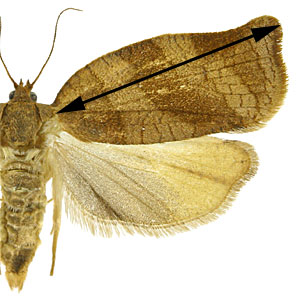 : 10-15 mm
: 10-15 mm
Head, thorax orange; forewing orange with two red spots along costacosta:
the anterior margin of each wing  representing median and terminal fasciaefascia:
representing median and terminal fasciaefascia:
a dark transverse band on the forewing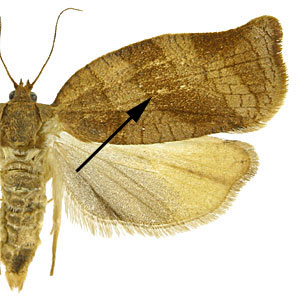 , additional spots between veins sometimes present along these fasciaefascia:
, additional spots between veins sometimes present along these fasciaefascia:
a dark transverse band on the forewing , but often obsolete or absent; male with forewing costal foldforewing costal fold:
, but often obsolete or absent; male with forewing costal foldforewing costal fold:
a flap or fold at the base of the forewing that contains specialized sex scales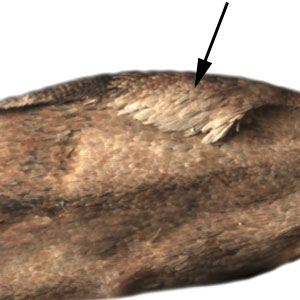 present; female termentermen:
present; female termentermen:
the outer edge of the forewing  sinuous; hindwing orange in both sexes.
sinuous; hindwing orange in both sexes.
Male genitalia are characterized by valvaevalva:
an appendage flanking the intromittent organ that is used to clasp the female during copulation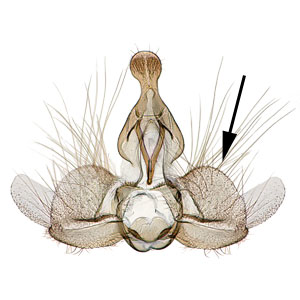 obliquely triangular, moderate, a finger-like uncusuncus:
obliquely triangular, moderate, a finger-like uncusuncus:
a sclerotized process which is fused to the posterodorsal margin of tergum IX ; and a pistol-shaped uncusuncus:
; and a pistol-shaped uncusuncus:
a sclerotized process which is fused to the posterodorsal margin of tergum IX . Female genitalia are characterized by a ductus bursaeductus bursae:
. Female genitalia are characterized by a ductus bursaeductus bursae:
a membranous tube connecting the ostium bursae to the corpus bursae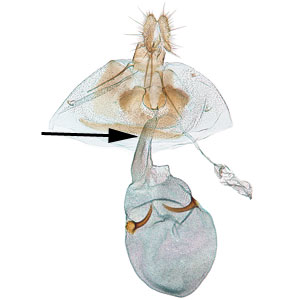 membranous; signumsignum:
membranous; signumsignum:
a sclerotized projection or patch on the interior of the corpus bursae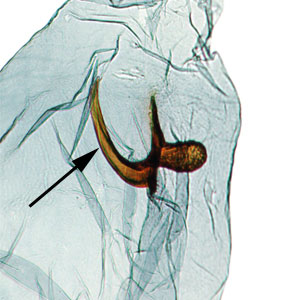 moderate, pointed.
moderate, pointed.
The following account is taken from MacKay (1962a).
Mature larva approximately 23 mm in length. Head, prothoracic shieldprothoracic shield:
a sclerotized plate on the dorsal surface of the prothorax 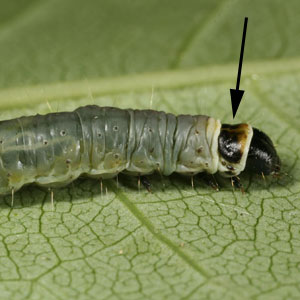 and legs dark brown; living larva yellow-green in color; pinaculapinaculum:
and legs dark brown; living larva yellow-green in color; pinaculapinaculum:
flattened sclerotized plates on a caterpillar that bear the setae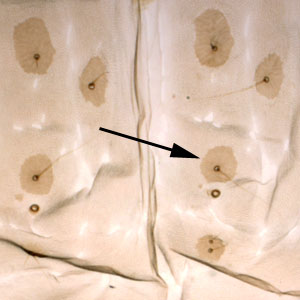 enormous, dark brown; anal fork absent; SV group on A1, 2, 7, 8, 9 usually 3:3:3:2:2.
enormous, dark brown; anal fork absent; SV group on A1, 2, 7, 8, 9 usually 3:3:3:2:2.
A more complete description of larval chaetotaxychaetotaxy:
the arrangement of setae (in reference to Lepidoptera larvae), often depicted on a "setal map"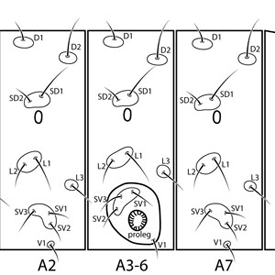 is available in MacKay (1962a).
is available in MacKay (1962a).
Archips rileyana is most similar to A. cerasivorana, a species with which it has sometimes been considered a subspecies (e.g., Freeman 1958Freeman 1958:
Freeman, T. N. 1958. The Archipinae of North America (Lepidoptera: Tortricidae). Canadian Entomologist, Supplement 7 (Vol. 90): 1-89.). Obraztsov (1959)Obraztsov (1959):
Obraztsov, N. S. 1959. Characters separating Archips rileyanus and cerasivoranus as two species (Lepidoptera: Tortricidae). Entomological News. 70: 263-267. considered it a full species, as have subsequent authors. The forewing of A. rileyana is more uniform in color and tends to have smaller, darker spots. The valvaevalva:
an appendage flanking the intromittent organ that is used to clasp the female during copulation of A. rileyana are more triangular than in A. cerasivorana, in which they tend to be fairly rounded. Female genitalia are very similar and almost indistinguishable. The larvae are significantly different in both their morphology and host preferences.
of A. rileyana are more triangular than in A. cerasivorana, in which they tend to be fairly rounded. Female genitalia are very similar and almost indistinguishable. The larvae are significantly different in both their morphology and host preferences.
Little is published on the life history or phenology of A. rileyana, but it is undoubtedly similar to A. cerasivorana except for preferred hosts. Larvae feed socially in webbed leaves through all instars throughout April with adults active from late May to early July.
Larvae of A. rileyana appear to have a preference for buckeye (Aesculus spp.), but have been recorded utilizing several other hosts.
| Host plant | Host plant family | Reference(s) |
| Vernonia sp. | Asteraceae | Freeman 1958Freeman 1958: Freeman, T. N. 1958. The Archipinae of North America (Lepidoptera: Tortricidae). Canadian Entomologist, Supplement 7 (Vol. 90): 1-89. |
| Symphoricarpos sp. | Caprifoliaceae | Meyrick MS 1938Meyrick MS 1938: Meyrick MS 1938. Unpublished manuscript by E. Meyrick at BMNH, data captured by Gaeden Robinson.; Freeman 1958Freeman 1958: Freeman, T. N. 1958. The Archipinae of North America (Lepidoptera: Tortricidae). Canadian Entomologist, Supplement 7 (Vol. 90): 1-89. |
| Cornus sp. | Cornaceae | MacKay 1962aMacKay 1962a: MacKay, M. R. 1962a. Larvae of the North American Tortricinae (Lepidoptera: Tortricidae). Canadian Entomologist, Supplement 28: 1-182. |
| Castanea sp. | Fagaceae | Kearfott 1907bKearfott 1907b: Kearfott, W.D. 1907b. Microlepidoptera from the Black Mountain Region of North Carolina, with descriptions of new species. Bulletin of the American Museum of Natural History. 23: 153-167. |
| Carya sp. | Juglandaceae | LACM IndexLACM Index: LACM Index. Records from the card file at the Los Angeles County Museum of Natural History, Los Angeles, California; transcribed by Gaeden Robinson (BMNH).; Meyrick MS 1938Meyrick MS 1938: Meyrick MS 1938. Unpublished manuscript by E. Meyrick at BMNH, data captured by Gaeden Robinson.; Freeman 1958Freeman 1958: Freeman, T. N. 1958. The Archipinae of North America (Lepidoptera: Tortricidae). Canadian Entomologist, Supplement 7 (Vol. 90): 1-89. |
| Juglans sp. | Juglandaceae | Freeman 1958Freeman 1958: Freeman, T. N. 1958. The Archipinae of North America (Lepidoptera: Tortricidae). Canadian Entomologist, Supplement 7 (Vol. 90): 1-89. |
| Prunus sp. | Rosaceae | Freeman 1958Freeman 1958: Freeman, T. N. 1958. The Archipinae of North America (Lepidoptera: Tortricidae). Canadian Entomologist, Supplement 7 (Vol. 90): 1-89. |
| Aesculus californica | Sapindaceae | USNM collectionUSNM collection: USNM collection. Based on identified reared specimens in the collection of the National Museum of Natural History, Washington, D.C.; MacKay 1962aMacKay 1962a: MacKay, M. R. 1962a. Larvae of the North American Tortricinae (Lepidoptera: Tortricidae). Canadian Entomologist, Supplement 28: 1-182. |
| Aesculus flava | Sapindaceae | USNM collectionUSNM collection: USNM collection. Based on identified reared specimens in the collection of the National Museum of Natural History, Washington, D.C. |
| Aesculus pavia | Sapindaceae | USNM collectionUSNM collection: USNM collection. Based on identified reared specimens in the collection of the National Museum of Natural History, Washington, D.C. |
| Aesculus sp. | Sapindaceae | Forbes 1923Forbes 1923: Forbes, W. M. T. 1923. The Lepidoptera of New York and neighboring states. Primitive forms, Microlepidoptera, Pyraloids, Bombyces. Cornell Univ. Argic. Exp. Sta., Mem. 68. 729 pp.; Freeman 1958Freeman 1958: Freeman, T. N. 1958. The Archipinae of North America (Lepidoptera: Tortricidae). Canadian Entomologist, Supplement 7 (Vol. 90): 1-89. |
View full screen host table here
Archips rileyana is primarily a southeastern species, with records from Pennsylvania to Missouri, south to Florida and Texas. California and Washington records in Obraztsov (1959)Obraztsov (1959):
Obraztsov, N. S. 1959. Characters separating Archips rileyanus and cerasivoranus as two species (Lepidoptera: Tortricidae). Entomological News. 70: 263-267. are likely based on misidentifications.